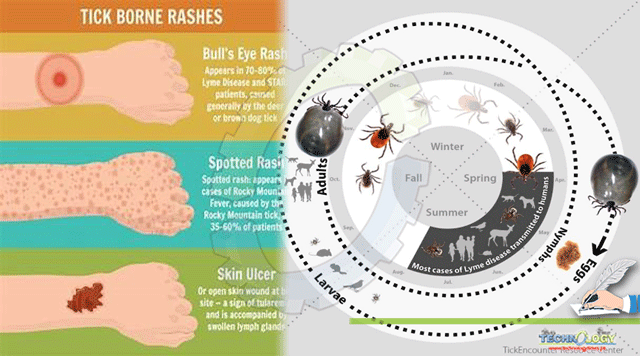The tick-borne pathogens, including their biological role as well as transmission pathways, has gained importance because of their ability to adapt to changing environments leading up to their global emergence, with the ultimate result of infecting humans and animals and contributing to huge economic losses worldwide.

By Iram Shaikh
Ticks are common and important ectoparasites, and many species easily feed on a variety of vertebrate hosts. Ticks are potential vectors and reservoirs of a large number of transmittable pathogens, Ticks have an enormous capacity to adapt to changing geo-climatic conditions and can therefore expand their range. They are known to be the primary vectors for the transmission of many pathogens of almost all origins such as viral, bacterial, rickettsial, and parasitic. To date, approximately 900+ species of ticks found throughout the world and are known to belong to three families: Ixodidae, Argasidae, and Nuttalliellidae (represented by a typical mono species limited to South Africa). After sucking blood, the outer surface of a tick reaches 200-600 times more than its unfed body weight. In Pakistan, the Hyalomma anatolicum has transmitted some of the tick pathogens that are of zoonotic importance, for example, Crimean Congo hemorrhagic fever, the main cause of granulocytic anaplasmosis is Anaplasma phagocytophilum which is considered as one of the most important species from a human’s point of view because of its zoonotic potential.
Ticks as parasites are vectors of many important human and animal pathogens such as Q fever Babesiosis, tick paralysis, hemorrhagic fever, Lyme disease (LD), tick-borne encephalitis, and tick-borne muscular fever. Rocky mountain spotted fever, which is caused by Rickettsia rickettsii, is a life-threatening, tick-borne disease, the largest ticks transmitted by veterinary or medically important causes three diseases anaplasmosis, cell spore disease, ehrlichiosis, theileriosis, and rickettsial disease.
A survey study was carried out in lower Sindh, (Tharparkar, Badin, Hyderabad, Karachi, Tando Muhammad khan, Thatta, and Mirpurkhas), Through the Department of Zoology, University of Sindh, Jamshoro. The study was designed to investigate district wise prevalence and detection of rickettsial agents using molecular and conventional techniques in blood samples of cattle, buffalo, sheep and goat from infested animals.
The study reveals that overall infection of Rickettsial agents in infested animals was recorded in Lower Sindh through Microscopy/ Blood smear test in cattle, buffalo, sheep and goat was 41.79%, 49.09%, 46 %and 41.66% respectively, whereas overall infection through PCR in cattle, buffalo, sheep and goat was recorded as 39.55%, 43.55%, 46% and 55.55% respectively-. The highest rate (83.33%, 81.25%, 66.66%, and 57.14%) of district wise prevalence of rickettsial agents through Microscopy/ Blood smear method in case of cattle, buffalo, sheep, and goat respectively was recorded from district Tharparkar, whereas the lowest rate (36.36%, 45.83%, 25%, and 28.57%) of district wise prevalence was recorded from Karachi district in case of cattle, buffalo, sheep, and goat respectively.
The highest rate (83.33%, 87.5%, 66.66%, and 71.42%) of district wise prevalence of rickettsial agents through PCR in case of cattle, buffalo, sheep, and goat respectively was recorded from district Tharparkar, whereas the lowest rate (30.30%, 41.66%, 25%, and 42.85%) of district wise prevalence was recorded from Karachi district in case of cattle, buffalo, sheep, and goat respectively.
In the several stages of life of ticks, they feed on the blood of birds, reptiles, amphibians, and mammals as well as humans. The blood-borne infection can be transmitted from a host animal through the tick because the tick can swallow that pathogen during its blood meal. When the tick bites a human, pathogens like bacteria, viruses, or parasites can be passed from ticks to humans. Tick-borne diseases can cause a huge decrease in productivity and economic losses in the livestock sector as well as cause debilitating illnesses in humans and their companion animals. we can take precautionary measures to avoid itching and the destructive effects of Lyme disease and other tick-borne illnesses, such as Rocky Mountain spotted fever, Powassan encephalitis, babesiosis, ehrlichiosis, and anaplasmosis, that can be transmitted by tick bites.
Currently, cedar oil spray, Homemade tick, and insect repellent, Eucalyptus oil, Neem oil, Apple cider vinegar, Certain aromatherapy essential oils (natural tick repellents), Eating garlic are used as natural and effective remedies and strategies to repel these nasty parasites without harmful chemicals in many countries.
Babesia and Theileria parasites are harmful to animal health and livestock farming in the world’s largest tropical and subtropical regions. In addition, human babesia is an increasingly serious public health problem. Most of these plastid studies focus on the stage of infection in mammals and their interaction with tick-borne animals is largely neglected. For millions of years, piroplasmids have been able to effectively use the tick environment for an important part of their life cycle. Self-reproduction, sexual reproduction, and recombination, the development of a form of infection that can persist in tick saliva in mammals and usually represents the survival of a new generation of ticks. The colonization of piroplasmids can seriously damage the tick’s tissues and organs, and the innate immune system can control these effects. I further examined the molecular interaction between ticks and piroplasms from different perspectives. A deeper understanding of the interface helps to develop new control strategies.
Author: Iram Shaikh,Ph.D Scholar and Medical Technologist ( BPS-17)